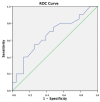Development of Algorithm for Clinical Management of Sickle Cell Bone Disease: Evidence for a Role of Vertebral Fractures in Patient Follow-up
- PMID: 32466239
- PMCID: PMC7291114
- DOI: 10.3390/jcm9051601
Development of Algorithm for Clinical Management of Sickle Cell Bone Disease: Evidence for a Role of Vertebral Fractures in Patient Follow-up
Abstract
Sickle-cell disease (SCD) is a worldwide distributed hemoglobinopathy, characterized by hemolytic anemia associated with vaso-occlusive events. These result in acute and chronic multiorgan damage. Bone is early involved, leading to long-term disability, chronic pain and fractures. Here, we carried out a retrospective study to evaluate sickle bone disease (SBD) in a cohort of adults with SCD. We assessed bone density, metabolism and turnover. We also evaluated the presence of fractures and the correlation between SCD severity and skeletal manifestations. A total of 71 patients with SCD were analyzed. The mean age of population was 39 ± 10 years, 56% of which were females. We found osteoporosis in a range between 7% and 18% with a high incidence of vertebral fractures. LDH and AST were predictive for the severity of vertebral fractures, while bone density was not. Noteworthy, we identified -1.4 Standard Deviations T-score as the cutoff for detecting the presence of fractures in patients with SCD. Collectively our data allowed us to develop an algorithm for the management of SBD, which may be useful in daily clinical practice to early intersect and treat SBD.
Keywords: Sickle cell disease; bone densitometry; management; osteoporosis; vertebral fractures.
Conflict of interest statement
The authors declare no conflict of interest.
Figures





References
-
- Matte A., Recchiuti A., Federti E., Koehl B., Mintz T., El Nemer W., Tharaux P.L., Brousse V., Andolfo I., Lamolinara A., et al. Resolution of sickle cell disease-associated inflammation and tissue damage with 17R-resolvin D1. Blood. 2019;133:252–265. doi: 10.1182/blood-2018-07-865378. - DOI - PMC - PubMed
-
- Vinchi F., De Franceschi L., Ghigo A., Townes T., Cimino J., Silengo L., Hirsch E., Altruda F., Tolosano E. Hemopexin therapy improves cardiovascular function by preventing heme-induced endothelial toxicity in mouse models of hemolytic diseases. Circulation. 2013;127:1317–1329. doi: 10.1161/CIRCULATIONAHA.112.130179. - DOI - PubMed
LinkOut - more resources
Full Text Sources

